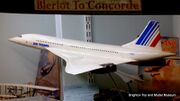Concorde, Air France (large shop-window model)
| Star Exhibit |
|---|
Concorde, Air France (large shop-window model) |
 |
| location: |
| Arch Two , Area 16 Aviation (display) |
| Shelf 1 |
A large shop-window-sized model of the BAC Concorde supersonic passenger aircraft. These sorts of larger aircraft models were typically made for travel agents' shop windows.
The original aircraft
Concorde flew commercially from 1976 to 2003, and was regarded by many as one of the most beautiful airliners ever built. Concorde achieved its sleek shape and smooth transonic aerodynamic profile with the aid of a very exact computer-modeled wingshape that worked well at supersonic and subsonic speeds, which the designers of the "derivative" Tupolev Tu-144 "Concordski" found difficult to copy with sufficient accuracy - according to one of the Concorde team, the exact shape was critical, it couldn't just be be approximated, it had to be derived.
Concorde had a wall-mounted "Mach meter" in the passenger section that showed when the aircraft was breaking through Mach 1.0, "the speed of sound". A journalist once famously asked the pilot what the "big deal" was about Concorde being able to go faster than Mach One, since the plane seemed to go from subsonic to supersonic without any obvious difference being noticed by the passengers, other than the numbers being shown on the counter. The fact that you didn't notice any difference, said the pilot, was the big deal.
Engine configuration
Concorde's Rolls Royce Olympus engines were almost embedded in the wings, with the intakes hugging the lower wing surfaces and the exhausts being in line with the wing trailing edges. Although this configuration was common in military aircraft for performance reasons, civilian aircraft designers had tended to avoid embedded engines in wings after the string of high-profile failures in the de Havilland Comet airliners, and had tended instead to hang the engines off the wings on suspended pods.
Concorde's use of a more "military" near-embedded engine design arguably made the plane more susceptible to catastrophic failure if an engines "threw" a turbine blade, since critical systems were closer to the engines. After the loss of a Concorde in Paris in July 2000, after uncleared metal debris left on the runway from an earlier plane entered an engine and the resulting turbine failure led to the plane's destruction, the "wing-hugging" configuration made it more difficult to get Concorde recertified for passenger flight, and the plane was withdrawn from service.



